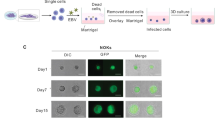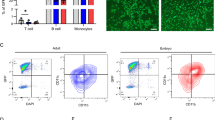Abstract
Background
Endothelial cells (ECs) exert immunological functions such as production of proinflammatory cytokines/chemokines as well as facilitation of extravasation of immune cells into infected tissue. Limited data are available on the functionality of ECs from extremely preterm neonates during infection. Accordingly, the aim of our study was to investigate the immune response of premature ECs after proinflammatory stimulation.
Methods
Cell adhesion receptors’ expression and function, nuclear factor 'kappa-light-chain-enhancer' of activated B-cells (NFκB) signaling, and chemokine production were analyzed in umbilical cord ECs from extremely preterm and term neonates after proinflammatory stimulation.
Results
P-selectin and E-selectin surface expression as well as NFκB signaling were lower after lipopolysaccharide (LPS) stimulation in premature ECs. Preterm ECs exhibited lower, but significant, cell-adhesive functions after LPS stimulation compared with term ECs. CCL2/CXCL8 chemokine secretion was significantly upregulated after proinflammatory stimulation in both groups. CXCL10 production was significantly increased in term but not in preterm ECs upon stimulation with tumor necrosis factor compared with unstimulated ECs.
Conclusion
Extremely premature ECs showed partly reduced expression levels and function of cell adhesion molecules. Both NFκB signaling and chemokine/cytokine production were reduced in premature ECs. The diminished endothelial proinflammatory immune response might result in impaired infection control of preterm newborns rendering them prone to severe infection.
Similar content being viewed by others
Log in or create a free account to read this content
Gain free access to this article, as well as selected content from this journal and more on nature.com
or
References
Stoll BJ, Hansen NI, Sanchez PJ et al, Early onset neonatal sepsis: the burden of group B Streptococcal and E. coli disease continues. Pediatrics 2011; 127: 817–26.
Simonsen KA, Anderson-Berry AL, Delair SF, Davies HD . Early-onset neonatal sepsis. Clin Microbiol Rev 2014; 27: 21–47.
Cortese F, Scicchitano P, Gesualdo M et al, Early and late infections in newborns: where do we stand? A review. Pediatr Neonatol 2015; 57: 265–73.
Gupta SK, Lysko PG, Pillarisetti K, Ohlstein E, Stadel JM . Chemokine receptors in human endothelial cells. Functional expression of CXCR4 and its transcriptional regulation by inflammatory cytokines. J Biol Chem 1998; 273: 4282–7.
Mitchell JA, Ryffel B, Quesniaux VF, Cartwright N, Paul-Clark M . Role of pattern-recognition receptors in cardiovascular health and disease. Biochem Soc Trans 2007; 35: 1449–52.
Murdoch C, Monk PN, Finn A. . Cxc chemokine receptor expression on human endothelial cells. Cytokine 1999; 11: 704–12.
Opitz B, Eitel J, Meixenberger K, Suttorp N . Role of Toll-like receptors, NOD-like receptors and RIG-I-like receptors in endothelial cells and systemic infections. Thromb Haemost 2009; 102: 1103–9.
Michiels C . Endothelial cell functions. J Cell Physiol 2003; 196: 430–443.
Kofler S, Nickel T, Weis M . Role of cytokines in cardiovascular diseases: a focus on endothelial responses to inflammation. Clin Sci 2005; 108: 205–13.
Cines DB, Pollak ES, Buck CA et al, Endothelial cells in physiology and in the pathophysiology of vascular disorders. Blood 1998; 91: 3527–61.
Lorenzon P, Vecile E, Nardon E et al, Endothelial cell E- and P-selectin and vascular cell adhesion molecule-1 function as signaling receptors. J Cell Biol 1998; 142: 1381–91.
Golias C, Batistatou A, Bablekos G et al, Physiology and pathophysiology of selectins, integrins, and IgSF cell adhesion molecules focusing on inflammation. A paradigm model on infectious endocarditis. Cell Commun Adhes 2011; 18: 19–32.
McEver RP . Selectins: initiators of leucocyte adhesion and signalling at the vascular wall. Cardiovasc Res 2015; 107: 331–9.
Muller WA . Leukocyte-endothelial-cell interactions in leukocyte transmigration and the inflammatory response. Trends Immunol 2003; 24: 327–34.
Nussbaum C, Gloning A, Pruenster M et al, Neutrophil and endothelial adhesive function during human fetal ontogeny. J Leukoc Biol 2013; 93: 175–84.
Nussbaum C, Sperandio M . Innate immune cell recruitment in the fetus and neonate. J Reprod Immunol 2011; 90: 74–81.
Lorant DE, Li W, Tabatabaei N, Garver MK, Albertine KH . P-selectin expression by endothelial cells is decreased in neonatal rats and human premature infants. Blood 1999; 94: 600–9.
Dogan A, MacDonald TT, Spencer J . Expression of cell adhesion molecules in the fetal gut. Adv Exp Med Biol 1995; 371A: 141–3.
Mariscalco MM, Tcharmtchi MH, Smith CW . P-Selectin support of neonatal neutrophil adherence under flow: contribution of L-selectin, LFA-1, and ligand (s) for P-selectin. Blood 1998; 91: 4776–85.
Schuller S, Wisgrill L, Sadeghi K et al, The TLR-specific adjuvants R-848 and CpG-B endorse the immunological reaction of neonatal antigen presenting cells. Pediatr Res 2016; 80: 311–8.
Wisgrill L, Groschopf A, Herndl E et al, Reduced TNF-alpha response in preterm neonates is associated with impaired nonclassic monocyte function. J Leukoc Biol 2016; 100: 607–12.
Marfaing-Koka A, Devergne O, Gorgone G et al, Regulation of the production of the RANTES chemokine by endothelial cells. Synergistic induction by IFN-gamma plus TNF-alpha and inhibition by IL-4 and IL-13. J Immunol 1995; 154: 1870–8.
Garcia AM, Fadel SA, Cao S, Sarzotti M . T cell immunity in neonates. Immunol Res 2000; 22: 177–90.
Lavoie PM, Huang Q, Jolette E et al, Profound lack of interleukin (IL)-12/IL-23p40 in neonates born early in gestation is associated with an increased risk of sepsis. J Infect Dis 2010; 202: 1754–63.
Sharma AA, Jen R, Brant R et al, Hierarchical maturation of innate immune defences in very preterm neonates. Neonatology 2014; 106: 1–9.
Mako V, Czucz J, Weiszhar Z et al, Proinflammatory activation pattern of human umbilical vein endothelial cells induced by IL-1beta, TNF-alpha, and LPS. Cytometry A 2010; 77: 962–70.
Acknowledgements
We want to thank Günther Hofbauer, Core Unit for Flow Cytometry, Medical University of Vienna, for technical assistance.
Author information
Authors and Affiliations
Corresponding author
Ethics declarations
Competing interests
The authors declare no conflict of interest.
Additional information
Statement of financial support
This work was supported by in-house funding from our institution.
Rights and permissions
About this article
Cite this article
Wisgrill, L., Muck, M., Wessely, I. et al. Endothelial cells of extremely premature infants display impaired immune response after proinflammatory stimulation. Pediatr Res 83, 128–134 (2018). https://doi.org/10.1038/pr.2017.202
Received:
Accepted:
Published:
Issue date:
DOI: https://doi.org/10.1038/pr.2017.202
This article is cited by
-
Early life growth is related to pubertal growth and adult height – a QEPS-model analysis
Pediatric Research (2025)
-
Sex-dependent differences in the secretome of human endothelial cells
Biology of Sex Differences (2021)
-
Dramatic changes in blood protein levels during the first week of life in extremely preterm infants
Pediatric Research (2021)



